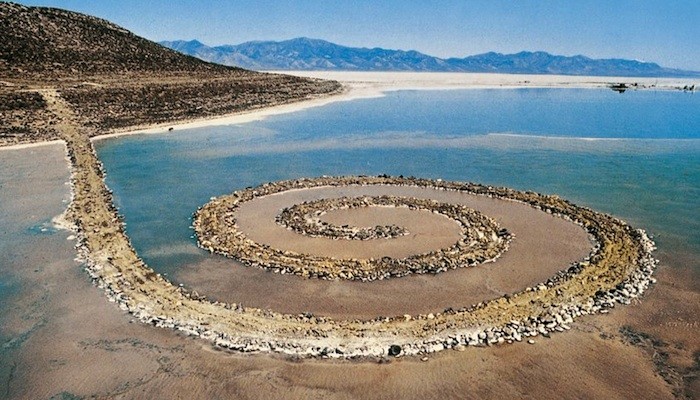In the 1960s a group of artists emerged in the United States who, driven by a sense of dissatisfaction with the increasing commercialization of art as well as the politically activist spirit of the times, began creating conceptually-oriented works that used or become part of the landscape in which they were situated. Looking to escape the strictures of the art-market establishment, these artists used found natural materials like rocks, soil, and trees to create works that couldn't be easily confined to a traditional gallery context, often working on a monumental scale.
Evolving in close relation to Minimalist art, with which it shared an unadorned, just-the-facts aesthetic, land art—alternatively termed earthworks, after the title of a British sci-fi book the land artist Robert Smithson admired—found heroic expression in the work of artists like Walter De Maria (whose 1977 piece The Lightning Field stood 400 metal poles on a New Mexico plateau) and Michael Heizer (whose 1970 Double Negative cut two gargantuan trenches, 30 feet wide by 50 feet deep by 1,500 feet long, into the Nevada desert). Smithson, meanwhile, created what is arguably the best known work of land art in the world with his monumental Spiral Jetty (1970), a rock formation built into northern Utah’s Great Salt Lake. Often situated in remote locations and made to incorporate their surrounding environments into both their creation and evolution as the deteriorate—entropy is a central aspect of many land art projects, especially Smithson's—many ephemeral earthworks now exist only in their documentary record.
Land art first garnered widespread attention as the result of two exhibitions, "Earth Works" (1968) at the Dwan Gallery and "Earth Art" (1969) at Cornell University, which featured documentation of the work being done by Smithson, De Maria, and Heizer, as well as Hans Haacke, Richard Long, Robert Morris, and others. Meanwhile, Smithson's landmark 1968 essay, "The Sedimentation of the Mind: Earth Projects," provided the movement with a theoretical grounding—placing it in opposition to the socially detached Modern art of the time—while at the same time his "non-sites" (accumulations of rocks or dirt brought into the gallery and surrounded by mirrors meant to "transport" the viewer to the detritus's point of origin) cannily provided a route into commercial settings. This not only helped the artists sell their work (the large outdoor pieces are typically patronage projects), it allowed urban audiences to engage with land art without having to travel to far-flung locales.
In fact, while many land artists—such as Nancy Holt, Richard Long, Ana Mendieta, and Andy Goldsworthy—focused on useing nature as both their medium and venue, others made a point of bringing socially conscious land art into the urban environment. Two artists in particular, Alan Sonfist and Agnes Denes, opted for a literal approach. In 1965 Sonfist began growing beech trees and other indiginous plans on a small plot of land in lower Manhattan for his work Time Landscape, an effort to create a sustainable urban forest, and the trees continue to grow to the present day. Denes, on the other hand, in a more overtly political statement, planted a two-acre field of wheat on a landfill (now Battery Park City) just blocks away from Wall Street and disperesed the over 1,000 pounds of grain she harvested to starving populations around the world. The artist duo Christo and Jeanne-Claude then famously draped 7,503 saffron-colored plastic sheets over Central Park in 2005 for The Gates, creating arguably the most-visited piece of land art in history, seen by over 4 million people.
Today artists continue to tackle land art—both in the wild and in cities and museums—through a multiplicity of strategies. Brazilian-born artist Paulo Nazareth works with materials he encounters in the world around him as a way of both reducing his role in material production as well as creating artworks with a more direct physical link to their areas of origin. Pedro Motta is a photographer based in Brazil who focuses on how architecture increasingly separates public and private space, and how the construction of buildings which fall to ruin even as they’re being built—disrupts their surrounding environments. The Iceland-based visual artist Rebekka Guðleifsdóttir creates photography that focuses on the evolving landscapes of her surrounding environment, frequently interposing her own body into her photographs—in a manner that recalls the work of Mendieta—to dissolve the perceived boundaries that separate human life from the natural world.
And while land art is today often tied to the '60s and '70s art scene, most of its original practionioners have hardly disappeared from the art world—they've simply gone underground, as it were, to create their most ambitious works to date. Heizer, for instance, has been devoting himself since 1972 to building City, a gargantuan earth sculpture built below ground level in the Nevada desert that employs building-sized shapes to evoke both Minimalism and the architecture of ancient civilizations; it is expected to be completed within the next few years. James Turrell, meanwhile, has been working since 1979 on Roden Crater, an immense artwork built into a three-mile-wide extinct volcano in Arizona that will function as an obsessively crafted viewing space to commune with the celestial bodies overhead; it is expected to be finished within the decade. (Both of these projects have had support from the Dia Art Foundation, a historic patron of land art.) As for Christo, he has since 1977 been planning to create Mastaba, a pyramid-like form built from 410,000 multi-colored oil barrels in an Abu Dhabi desert that will be the largest sculpture in the world; he recently obtained funding from the emirate's royal family to begin work on the project.



























